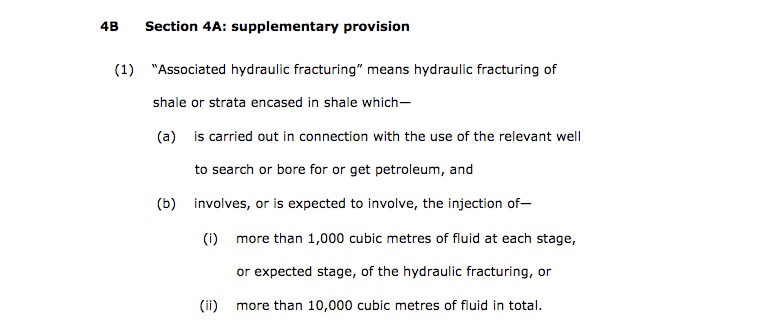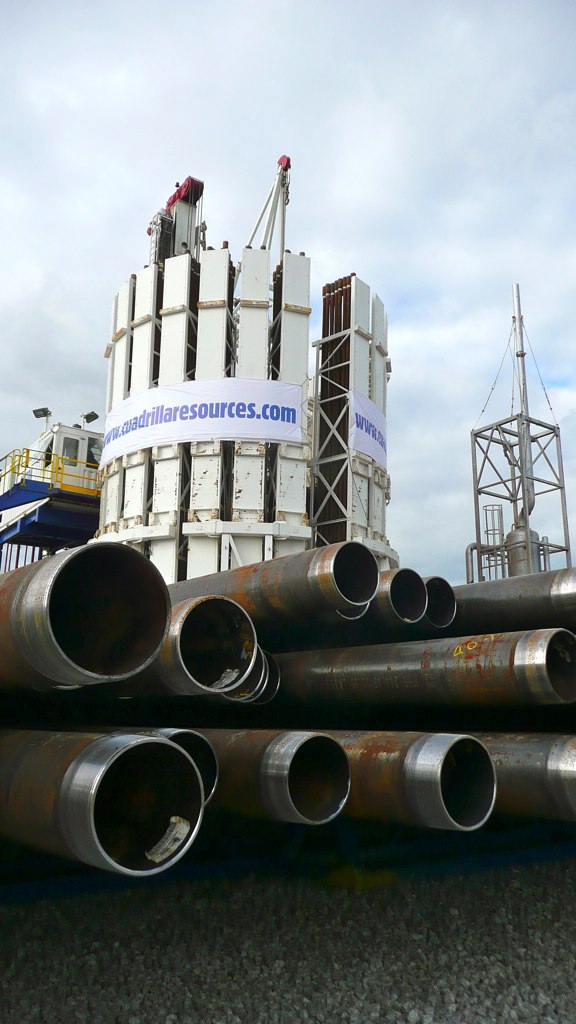Last week, DeSmog UK revealed how David Cameron’s government snuck a new definition of fracking onto the statute books. Kyla Mandel investigates where this definition actually came from.
The definition of hydraulic fracturing adopted by the UK coalition government has all the hallmarks of industry influence, finds DeSmog UK.
The fracking definition was slipped into the controversial Infrastructure Act without a chance for MPs to vote on it. And it is almost identical to that recommended by the European Commission in January 2014.
However, both of these definitions are based solely on the volume of fluid used during fracking and are closely aligned with the shale gas industry’s specific definition of hydraulic fracturing.
‘Political Definition’
Antoine Simon, extractive industries campaigner at Friends of the Earth Europe, said: “Long story short, this is a political definition of fracking, but surely not a scientific one.”
According to the EU Recommendation ‘high-volume hydraulic fracturing’ means: “injecting 1,000 m3 or more of water per fracturing stage or 10,000 m3 or more of water during the entire fracturing process into a well.”
Source: European Commission Recommendation on ‘High-Volume Hydraulic Fracturing’ January 2014
The UK definition adopted into the Infrastructure Act however expands on this definition. Where the EU specifically refers to ‘high-volume’ fracking, Britain simply uses the term ‘associated hydraulic fracturing’ and replaces ‘water’ with ‘fluid’.
Source: UK Infrastructure Act 2015
“I’ve never come across one peer-reviewed study that defined ‘high-volume hydraulic fracturing’ with these water use thresholds” Simon told DeSmog UK. “However, these figures must come from somewhere. Maybe from one study I’m not aware of.”
And there certainly have been many studies. In 2014 alone there were 173 peer-reviewed studies on fracking, with 141 published in 2013 and 67 in 2012.
So where did these definitions come from?
Definition Source
According to Florence Limet of the European Commission’s Directorate-General for the Environment (DG Environment) the Commission’s definition is drawn from a study conducted by sustainability consultants Ricardo-AEA on behalf of the DG Environment.
As the study states:
Within the scope of this study, hydraulic fracturing is to be understood as the cycle of operations from the upstream acquisition of water, to chemical mixing of the fracturing fluid, injection of the fluid into the formation, the production and management of flowback and produced water, and the ultimate treatment and disposal of hydraulic fracturing wastewater.
Hydraulic fracturing is used for vertical wells in conventional oil and gas formations to a limited extent in Europe and to a considerable extent in the US. Hydraulic fracturing is used in vertical and directional wells in unconventional formations.
It then proceeds to describe high-volume hydraulic fracturing as related solely to directional, or horizontal, fracking. This is the type of fracking associated with unconventional gas such as shale.
It advises that: “In the European context, it appears that a definition of 1,000 m 3 per stage would be a more appropriate working definition.” This is based on examples of shale gas extraction from the Netherlands, Poland and Denmark. It is this definition which the European Commission put into its Recommendation.
As Simon noted, the recommendations published by the European Commission are “extremely political and the people behind this document are not only the technical experts from the Commission but also a working group of experts from each interested Member State.”
The UK Infrastructure Act does not use the term ‘high-volume’ and instead says “associated hydraulic fracturing of shale.” It also adds that it must be “carried out in connection with the use of the relevant well to search, bore for or get petroleum.”
In neither of these definitions does fracking include the creation of the well.
Industry Echoes
This echoes industry definitions closely. According to Shale Gas Europe — an online resource centre set up by the industry and supported by Chevron, Cuadrilla, Shell, ExxonMobil and Halliburton — there are two processes associated with the extraction of shale gas: drilling operations and hydraulic fracturing.
As it explains, drilling creates the shale gas well and is not part of the extraction process. Hydraulic fracturing, the second step, “involves fracturing fluid being pumped at high pressure into the shale rock in order to open fractures”.
By defining fracking as one specific phase in the entire process, it means that any environmental impacts that do occur must be proven to be associated with that specific phase in order to claim that the industry definition of fracking has caused that impact.
As Dr Ronald Bishop from State University of New York, College of Oneonta, previously told DeSmogBlog, the gas industry commonly claims that “no proven instances of water contamination have occurred due to hydraulic fracturing.”
This “misleading statement” uses the industry’s definition of hydraulic fracturing “which excludes incidents from drilling damage, failed well casings, spills, erosion and sediment, or tanker accidents,” Bishop explained.
Outside the Scope
Creating a specific definition of fracking that both limits it to one phase of the extraction process as well as the volume of fluid used works to further exclude some instances from being classified as fracking, thereby exempting them from any safety regulations imposed by the government.
For example, Cuadrilla’s exploratory fracking for shale gas at Preese Hall in Lancashire in 2011 would not be considered fracking under the UK’s new definition, because it only used 8,400 cubic metres of water in total.
Under the UK definition it states fracking must use more than 10,000 cubic metres in total or more than 1,000 cubic metres at each stage. It is unclear how Cuadrilla’s Preese Hall operations would be viewed under this second clause as the volume of fluid used at each of the six stages varied widely between a mere 39 cubic metres to more than 2,000 cubic metres.
However, this fracking operation had to be shut down because it caused two earthquakes, demonstrating that a lower total volume of fluid can have adverse impacts on the environment.
In Germany, a fracking moratorium has been imposed, but this may soon be lifted. In the meantime, the country has developed some tight gas projects — another type of unconventional gas — which requires the same fracking process for extraction.
Due to the geology where the tight gas is trapped, less water and fewer chemicals are required to extract it compared to shale gas extraction, Simon explains. It would therefore not fall under the scope of the European Commission’s recommendation.
But not everyone defines fracking this way. And certainly not this specifically.
The Whole Process
“The problem is that ‘fracking’ means different things to different people,” writes the New York Times.
The Royal Society, the UK’s national Academy of Science, for example, defines fracking as “a means of increasing the flow of oil or gas from a rock formation by pumping fluid at high pressure into the well, causing fractures to open in the formation and increase its permeability.”
In the United States, the Environmental Protection Agency (EPA) expands fracking beyond just one phase, stating: “the process of hydraulic fracturing begins with building the necessary site infrastructure including well construction.”
Everyone agrees fracking a horizontal shale gas well uses large volumes of water. But the Pacific Institute states “the amount of water required is both variable and uncertain”. So defining fracking solely by the amount of water used is clearly not credible.
The scope chosen by environmental impact studies also sheds some light onto what researchers view as fracking.
The British Geological Survey (BGS), for example, has chosen to take a wider scope in its research.
In January of this year, it launched a new study to monitor the impacts of shale gas exploration and production in Lancashire. Lancashire is at the forefront of British fracking; Cuadrilla is currently seeking planning permission for up to four wells.
Cuadrilla defines hydraulic fracturing as “only one phase of the well development process” and it is “usually performed at the start of the life of a well.”
But as the BGS explained to DeSmog UK, in the context of its study “we refer to ‘hydraulic fracturing’ as the whole process from drilling right through to flow back fluid/waste water disposal including the actual process of hydraulic fracturing itself”.
George Orwell famously wrote in Politics and the English Language that “the slovenliness of our language makes it easier for us to have foolish thoughts”.
It seems the energy industry by taking control of the definition of fracking has made it almost impossible to regulate it – and in doing so has made fools of us all.
DeSmog UK has contacted the Department of Energy and Climate Change (DECC) for a statement clarifying where the fracking definition came from in the Infrastructure Act. At time of publication DECC had yet to respond.
Photos: Justin Woolford via Flickr
Subscribe to our newsletter
Stay up to date with DeSmog news and alerts









